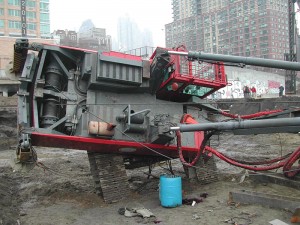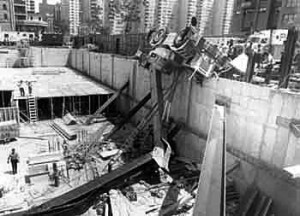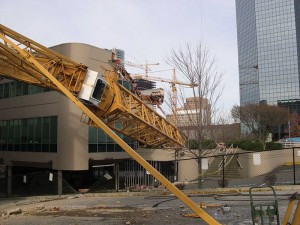This is Part 3 of a series of articles introducing illustrative examples of changes in design and construction codes, standards, regulations and practices that have followed catastrophic failures of construction cranes. Part 1, in the December 2010 issue of STRUCTURE®, focused on bridges, Part 2 in the April 2011 issue focused on buildings, and Part 3 is devoted to construction cranes.
It is a credit to our structural and construction engineering professions that failures have been and continue to be used to improve design, construction and regulatory practices. We do not just pay up, rebuild and walk away – we delve, we learn, and we improve.
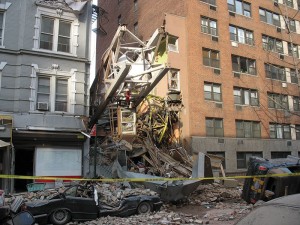
Figure 1: On the Upper East Side of Manhattan, a tower crane collapsed during a climbing operation, resulting in multiple deaths and massive property damage.
A crane accident in the core of a large city can be a dramatic event that splashes across television screens and tabloid covers (Figure 1). Government officials are compelled by public outcry to react; their constituents must be made to feel safe while walking through streets stalked by the shadows of giant construction cranes. Under such circumstances, major accidents in dense urban zones have spurred the creation of crane regulations, particularly in California, New York City and the UK. Officials in other localities have reacted similarly to singular dramatic accidents, sometimes creating laws that are closely crafted to the particularities of the accidents that spawned them.
This jagged path to the making of crane rules is an aberration. The great bulk of crane standards and regulations in both the United States (US) and the world at large are, instead, the product of a steady progression of deliberations, built upon collective knowledge and wisdom acquired over decades. Much of the knowledge, unfortunately, comes from the experience of accidents.
Most crane accidents do not occur in the center of major cities, nor do they make the front pages of tabloids. These lesser-publicized events add up to a much greater human and economic toll than the headline-grabbers. They do not, however, escape attention. Stakeholders, who suffer the losses and deal with the consequences, do not ordinarily forget them (Figure 2). For those apt to learn from experience, the cruel lessons of a serious mishap will be internalized, analyzed and applied.
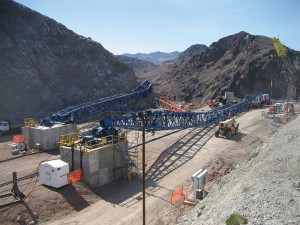
Figure 2: A half-mile-long cableway across Black Canyon on the Colorado River collapsed during high winds. Its loss set back construction of a vital interstate bridge link by two years.
There are also many incidents that might be termed near-misses or minor mishaps. These frightening brushes with catastrophe can be moments of serendipity for those inclined to learn from them. For the small fraternity of participants in standards-writing committees, hard-learned lessons from failures in the field become opportunities to contribute to the advancement of industrial codes.
Crane Uses and Their Hazards
Cranes are broadly classified into the categories of Industrial, Construction and Marine. Some crane and rigging rules overlap in covering all three, while others are particular. For example, the American Society of Mechanical Engineers’ ASME B30.20: Below-the-Hook Lifting Devices covers lifting accessories for all cranes, while ASME B30.3: Construction Tower Cranes is targeted for its construction specificity.
Industrial cranes usually operate in well-controlled settings, with operations that are repetitive and equipment that is often fixed in place or operating in circumscribed zones. Some common crane types in general industry are stackers, loaders, bridges and gantries. Accidents mostly occur from complacency, lack of training, inadequate supervision or deficient maintenance. (These causes could also serve to explain a great many industrial accidents outside of the crane and rigging sphere.) After all, cranes are subjected to abuse and prone to failure just like other mechanical contrivances used by general industry.
The things that cause most accidents in general industry can cause construction crane accidents as well, but construction sites introduce additional hazards. Site conditions are short-lived and ever-changing; personnel rotate through, and the operations of the various trades overlap. Mobile cranes and tower cranes, the types most common on construction sites, each engender a distinctive set of hazards that are unique to their class. Their users require specialized knowledge and procedures that are additional to the general set of rules for cranes and rigging.
An informative discussion of the types, installation, operation and safety issues of construction cranes is in Chapter 20, “Cranes,” by L. K. Shapiro, in Temporary Structures in Construction, 3rd edition, R. T. Ratay, Editor, McGraw-Hill, Inc., 2010.
The special nature of crane hazards on construction sites demands that particular rules exist for that milieu. That is why, for example, the Occupational Safety and Health Administration (OSHA) maintains an extensive section about cranes under its construction standard (29 CFR 1926 Subpart CC: Cranes and Derricks in Construction) that is separate from its standards for general industry.
US Crane Standards
Out of professional considerations, as well as from long-term self-interest, stakeholders have often organized to produce codes for the safe design and operation of cranes. Such voluntary efforts long predate government regulation. The collective wisdom of many experts gathering year-after-year has produced some well-known and widely-utilized series of rules, particularly the B30 series sponsored by the American Society of Mechanical Engineers (ASME). Important US standards are also produced under the tutelage of the American Petroleum Institute (API) and the Society of Automotive Engineers (SAE).
These rules are considered consensus standards. Though lacking legal clout, their authority arises from the broad expertise of those who write them, and from the dedication of the sponsoring organizations to promote for the public interest. It is widely understood, but rarely stated, that sound standards are not just for the broad public good, but confer direct benefits to individual stakeholders. By promoting best practices they improve safety, and by promoting consistency of practices they remove a large measure of uncertainty from the industrial milieu.
Though consensus codes and standards do not have the force of law, they oftentimes are incorporated into laws or are treated as de facto laws by regulatory and enforcement authorities. They are frequently cited in civil litigation and thus are well-entrenched in the common law.
The list of stakeholders in the crane and rigging industry is long. A crane in service usually has a manufacturer, an owner, a user, an operator in the seat, a tradesman, often a construction manager or general contractor, and a project owner. There are also project planners, component manufacturers, engineers, safety professionals and regulators. Though some have a more dominant presence than others, all are represented at the table during codes and standards development.
Causes of Crane Accidents in Construction
In the US, most medium-sized and large construction sites are serviced by mobile cranes. Their variety, purposes and duration of use vary greatly. A truck-mounted mobile crane may show up at a site to make a handful of picks before departing, while a crawler crane could be set up for a year-long assignment. Mobility confers its own set of hazards, inferring likelihood that an operating site has not been adequately surveyed beforehand and perhaps not prepared for the presence of a crane. Moreover, the operator and crew may be encountering unfamiliar conditions with unexplored hazards. Mobility also confers the possibility of last-minute changes or improvisations, defeating the benefit of a plan.
Among mobile cranes, the frequent types of serious accidents are:
- Electrocution – the victims is usually a rigger handling the load when the boom or load line contacts an overhead power line.
- Overturning – caused by overloading, ground support failure or improper operation of the crane (Figure 3).
- Collision – a portion the crane or a suspended load strikes a building, person or object, or a suspended load is trapped.
- Over-travel – the load block strikes the boom tip or boom runs up against the backstops.
- Structural failure – from excessive side loading, overloading or an equipment deficiency.
- Assembly/disassembly failure – the crew deviates from a qualified procedure.
- Crushing – a worker is caught by a rotating or moving part such as a revolving deck or a spooling rope.
The same types of accidents can occur with tower cranes, albeit less frequently because tower cranes tend to work under more controlled circumstances than mobile cranes. Tower cranes are used in the US primarily on major construction sites. By nature, they are fixed or semi-fixed in place and, therefore, less prone to problems caused by scanty planning, hasty preparation or last-minute improvisation. The greatest exposure of these machines to accidents occurs when they are being erected, dismantled or jumped.
Crane Failures, Codes and Standards
Though “code” and “standard” are words that are sometimes used interchangeably, the first implies a mandate while the latter is more often voluntary. The history of crane standards in the US is longer than that of codes, beginning with the first ASME issuance in 1916. Earlier standards, promulgated by the industry policing itself, focused on crane design and work practices. The same subject matter has evolved over the decades and can be found in contemporary standards, but new topics have been added. Recent developments have focused on personal responsibilities and qualifications, as well as requirements for devices to enhance safety. These changes have often been in response to catastrophic failures.
Early government regulation of the crane and rigging industries was light, mostly occurring at the state level. The most significant development in the regulatory landscape took place when the OSHA act of 1970 was signed into law. With that pen stroke, the federal government became the dominant regulator of crane and rigging practices.
OSHA regulations lagged behind industry standards until 2010, when a broad update of OSHA construction crane regulations went into effect. Up until then, OSHA filled in the gaps by enforcing consensus standards as the de facto law. The 2010 regulations absorbed much from these consensus standards, but also moved beyond them. In developing the new regulations, OSHA consulted with a panel of industry experts and applied cost-benefit analyses in addition to unalloyed safety considerations. Though portions of the regulations remain controversial in the industry, the agency clearly based its work on a broad view without reacting “knee-jerk” to particular events of failures.
In spite of the new robust OSHA crane rules, localities that have their own regulations are unlikely to back away from them. The most entrenched of these rules – in New York City, Chicago and California – are justified by officials as being necessary to provide an extra layer of protection for the citizenry in densely populated urban spaces.
Some of the background for these rules is instructive, as described in the following examples of crane failures that precipitated changes in codes, standards and practices.
Illustrative Cases
New York City 1985 East 63rd Street Mobile Crane Overturns Onto a Pedestrian
Since 1968, New York City has had the most comprehensive crane laws in the country, requiring engineering certification and City approval of models, registration and inspection of individual machines, and professional engineering design for field installations. Notwithstanding these requirements, serious failures have occurred, some of them spurring revisions to the existing regulations.
In May 1985, during the early phase of construction of a residential high-rise building, a 35-ton telescopic crane turned over onto a passerby, pinning her precariously between the crane and the foundation wall (Figure 4). The ensuing dramatic rescue of the woman, who had been walking by the site on an open public sidewalk, brought national attention including a television movie and a presidential bedside call. Investigators determined that the crane had been operated by a laborer who had hastily jumped in the operator’s vacant seat to unload a truckload of rebar that had arrived during lunch break. In the haste to complete the task before the regular operator’s return, he had failed to extend the outriggers fully. When the boom swung over the side of the crane with the load on the hook, it toppled towards the site.
The incident prompted city officials to strengthen administrative rules both for cranes and for general site safety, and a new site safety enforcement unit was created within the Department of Buildings. New administrative rules required on-site inspection of each crane by a professional engineer prior to its operation, assignment of a person to be responsible for safe crane operation and certification of site safety managers. In ensuing years, these measures have been greatly expanded.
San Francisco 1989 Tower Crane Collapse
In November 1989, a 350-foot tall tower crane constructing a downtown San Francisco high-rise office building collapsed while engaged in a climb. Five people were killed, including two passers-by. With a mangled wreckage and key witnesses among the dead, the cause was not easily discerned. However, investigators eventually determined that the upper part of the crane had been rotated during a critical stage of the climb. The act of rotation threw the crane out of balance and loaded the climbing apparatus above its ultimate capacity.
As a result of this catastrophic failure, the California state legislature turned its attention to tower cranes, which had previously been given scant regulatory scrutiny at the state level. Labor Code Sections 7375-7384, that followed the 1989 incident, enabled a strict regimen of inspections, the most stringent in the country. Some of these inspections are now performed by state-certified private inspectors and others by Cal/OSHA. A qualified inspector is also required to be present during climbs and when dismantling a tower crane.
Though tower crane inspection rules have toughened around the country, none approach the stringency of California except perhaps for New York City.
Bellevue, WA 2006 Tower Crane Collapse
On a November night, a 210-foot-tall freestanding tower crane constructing a high-rise building toppled onto several adjoining buildings, killing one occupant (Figure 5). The project had been redesigned and recently restarted after an earlier abandonment. With the old tower crane footing not in a suitable location, a new base support had been established on a fabricated steel frame attached to columns and shear walls in the underground garage.
Due to a serious communication gap, the base designer was working with assumptions that differed drastically from the actual conditions on the site. The base designer used loads provided by the crane supplier and relayed by the general contractor, with the clear understanding that the crane would be erected with a tie connecting its mast to the building core, such that there would be no overturning moment on the base. However, the general contractor erected the crane initially as freestanding with no tie, thus imposing significant overturning moments on the base that far exceeded its capacity.
Triggered by this failure, two crane-safety bills were introduced in the Washington state legislature: Senate Bill 5990 and House Bill 2171, signed into law in 2007, making the state’s new crane safety regulations among the nation’s strictest. Effective January 1, 2010, the Crane Safety Act requires, among other things, cranes to be load-tested, inspected, and certified at least annually, after any significant modification or repair of structural parts, and before and after each setup at a new site. It also requires crane owners to have an independent professional engineer review and approve plans for any non-standard tower crane base.
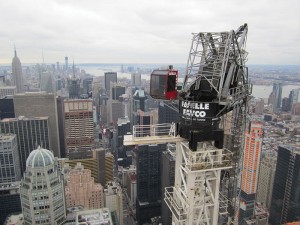
Figure 6: A tower crane boom flipped backwards during Hurricane Sandy, dangling above the streets of Manhattan.
New York City 2012 Crane Boom Failure during Superstorm Sandy
In October 2012, a high-profile failure occurred after the final stages of erecting a 90-floor residential building in mid-town Manhattan. At the height of Superstorm Sandy, the boom flipped backwards and hung menacingly until it was secured several days later (Figure 6). The failure drew public attention for the spectacle high above the streets. Among engineers and regulators, it left questions concerning the adequacy of existing practices for leaving tower cranes to “weathervane” in high winds. The incident is still under review and is likely to spur new regulations.
Closure
In the not-too-distant past, a crane accident was treated primarily as an economic loss. The economic impact has not diminished from times past, but the social cost has increased. Society is much less tolerant of accidents and more inclined to assign blame. The calculus of risk management has shifted away from being a mere actuarial exercise; the stigma following a failure can seriously damage a company or a career, including the possibility of criminal prosecution. Beyond all these, injury or loss of life results in wrenching human suffering.
Crane accidents will always occur, as humans, materials and machines are imperfect, hazards are sometimes hidden, and nature is fickle. The burden of our profession and our industry is to learn from things that go wrong, develop corrective means and strategies and apply them. Laws and standards are merely one set of means to mitigate.▪

